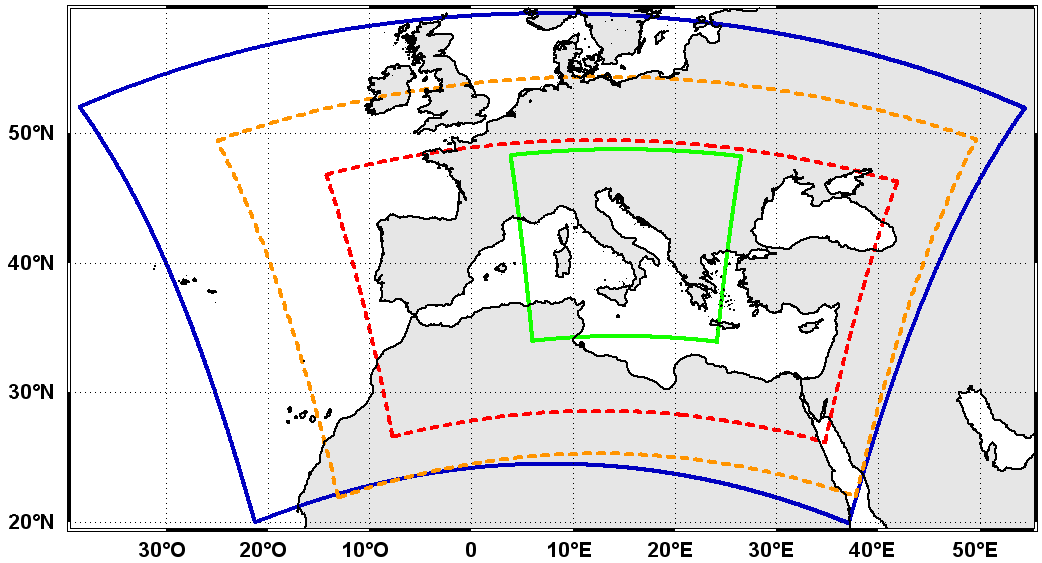|
Menù di navigazione principale
|
Meteorological ForecastsBOLAM and MOLOCH modelsThe hydrostatic BOlogna Limited Area Model (BOLAM) that is operational in ISPRA within the Hydro-Meteo-Marine forecasting System (SIMM - Sistema Idro-Meteo-Mare) is a parallel version of the model developed by Bologna branch of the Institute of Atmospheric Sciences and Climate of the Italian National Research Council (ISAC-CNR). Presently, BOLAM is operational over a 0.07° domain, covering most of Europe and part of the north-eastern Atlantic Ocean and of Sahara, and it is implemented on a 256-core HPC Linux cluster. The model was originally designed at the end of 90s
to run on two one-way nested grids, whose horizontal
grid spacings are 0.3° (father domain) and 0.1° (son
domain), respectively, and it was then implemented in
2000 on a
128-processor QUADRICS parallel machine by Alenia (because
of this the model configuration was labelled QBOLAM).
Successively, an updated model version was implemented
on a SGI-Altix parallel machine, using the same two
one-way nested grids. This latter configuration worked
alongside the updated 0.07° configuration until
September 2019. In the right-hand figure, it is reported the 0.07° domain that is currently used in the operational configuration (solid blue line). The coarser domains of the previous operational configuration, namely the 0.1° domain (dashed red line) and the 0.3° domain (dashed orange line), are also included. As seen from the figure, since 2000, the SIMM's BOLAM was one of the first Italian models able to provide 10-km meteorological forecasts over the entire Mediterranean Basin. Since the end of 2012, a very high resolution (0.0225°) configuration of the non-hydrostatic MOLOCH model covering Italy (see the solid green line in the figure), developed by ISAC-CNR as well, has been added to the SIMM meteorological component. The strong collaboration between ISPRA and ISAC-CNR make possible to adopt operationally the most updated versions of the BOLAM and MOLOCH models. Currently, it is implemented in the SIMM forecasting chain the 2019 model code versions. BOLAM is initialised by means of analyses and forecasts provided by the European Centre for Medium-Range Weather Forecasts (ECMWF) Integrated Forecasting System (IFS), considering both the 1200 UTC run (from the previous day) and the 0000 UTC run (from the current day), while MOLOCH is initialised using 0.07° BOLAM forecasts provided by the two runs. Within the SIMM forecasting chain, BOLAM and MOLOCH are then coupled with a wave forecasting system, named MCWAF, to provide medium-range sea state forecasts for the Mediterranean Sea on a regional and coastal scale, and a sea surge model, named SHYFEM, to forecast tide events in the Northern Adriatic Sea and, in particular, in the Lagoon of Venice (for acqua alta events). 132-h forecasts (5 days and half) over the Mediterranean Basin, for several surface and level fields (all at hourly time scale), modelled by the 0.07° BOLAM are available in the "0.07° BOLAM forecasts over the Mediterranean Basin" session, whereas 84-h forecasts over Italy provided by MOLOCH are available in the "MOLOCH forecasts over Italy" session. Time cross-sections of forecast data of mean sea level pressure, hourly precipitation, 2-m temperature, 2-m relative humidity and 10-m wind for several Italian places provided by the 1200 UTC BOLAM run are available in the "Meteograms" session. The update of the 1200 UTC BOLAM forecast maps is available around 23:00 CEST, whereas the update of the 0000 UTC BOLAM forecast maps is available around 10:45 CEST. The updates of the MOLOCH forecast maps provided by the runs are available half an hour later. In each map, it is indicated with INIT. the date and time of the ECMWF IFS run used for the initialisation (even for MOLOCH since IFS is the global model presents at the head of the forecasting meteorological chain), with VALID. the forecast validity time, and with T the time (in hours) elapsed from initialisation. A more detailed description of SIMM is available in the "Hydro-Meteo-Marine forecasting System" session or in the several works available in the "Publications and presentations". Additional information, in particular about the meteorological component of the system, can be requested to: simm-pre-meteo@isprambiente.gov.it. |

